《机器学习公式推导与代码实现》学习笔记,记录一下自己的学习过程,详细的内容请大家购买作者的书籍查阅。
XGBoost
从算法精度、速度和泛化能力等性能指标来看GBDT,仍然有较大的优化空间。XGBoost是一种基于GBDT的顶级梯度提升模型。相较于GBDT,XGBoost的最大特性在于对损失函数展开到二阶导数,使得梯度提升树模型更能逼近其真实损失。
XGBoost全称eXtreme Gradient Boosting,即极限梯度提升树,由陈天奇在其论文XGBoost:A Scalable Tree Boosting System中提出。
1 XGBoost介绍
XGBoost本质上仍属于GBDT算法,但在算法精度、速度和泛化能力上均要优于传统的GBDT算法。从算法精度上来看,XGBoost通过将损失函数展开到二阶导数,使得其更能逼近真是损失;从算法速度上来看,XGBoost使用了加权分位数sketch和稀疏感知算法这两个技巧,通过缓存优化和模型并行来提高算法速度;从算法泛化能力上来看,通过对损失函数加入正则化项、加性模型中设置缩减率和列抽样等方法,来防止模型过拟合。
下面我们就在GBDT框架的基础上,通过详细的数学推导,来深入理解XGBoost算法:
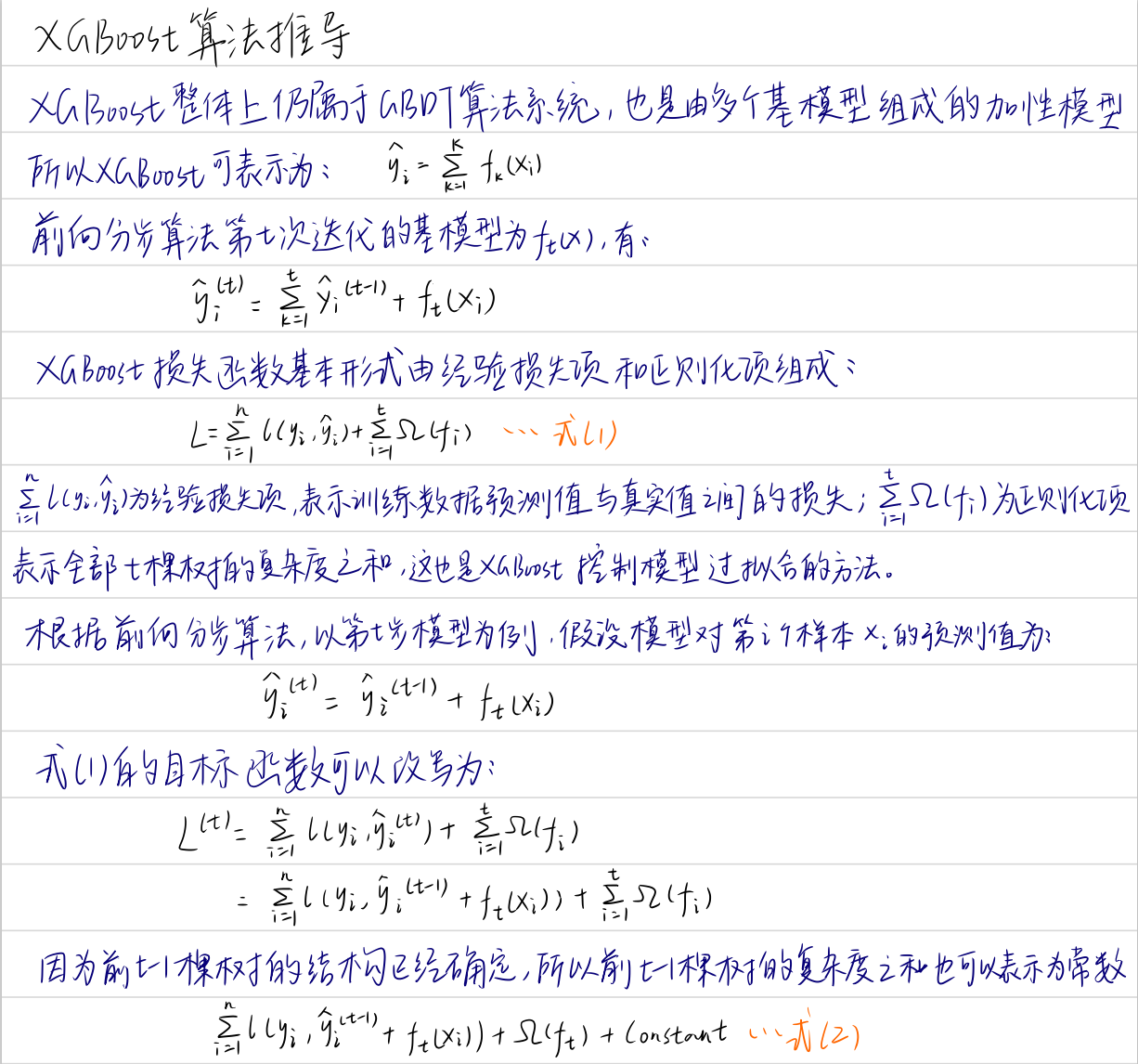
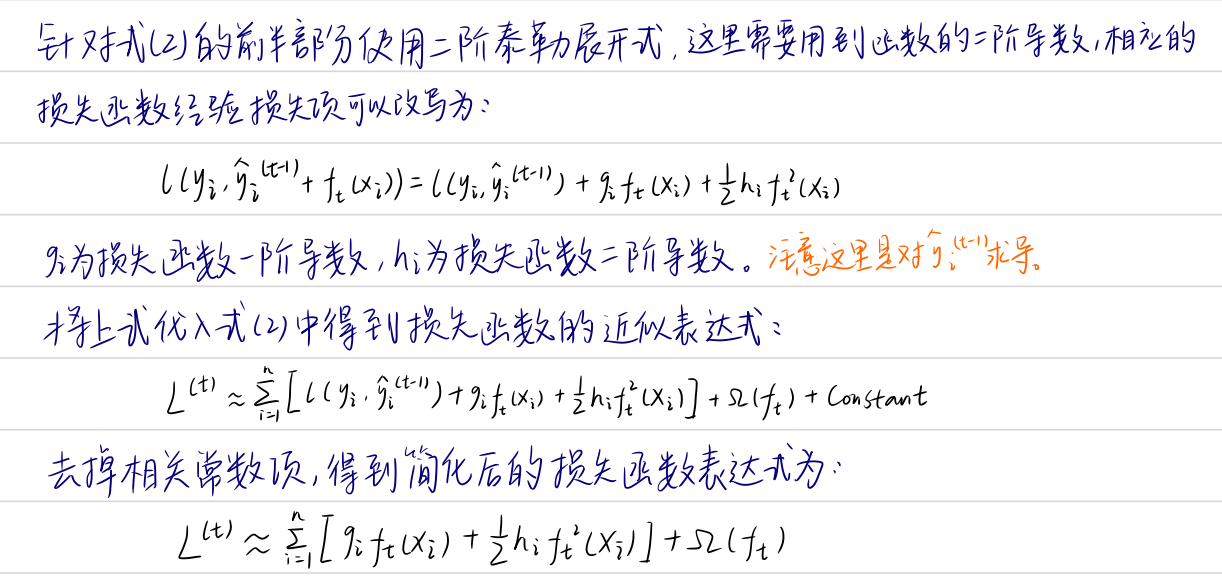
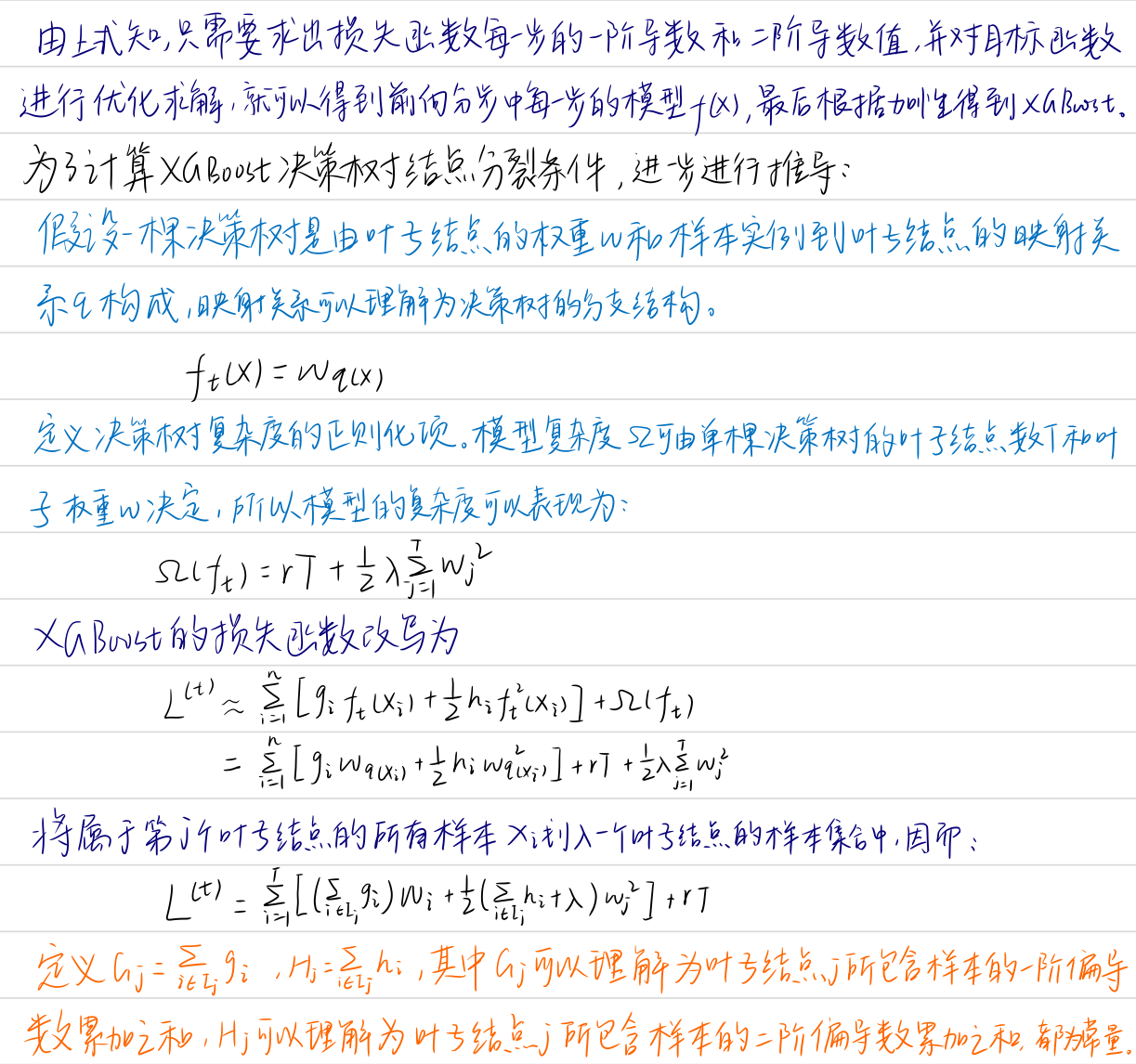
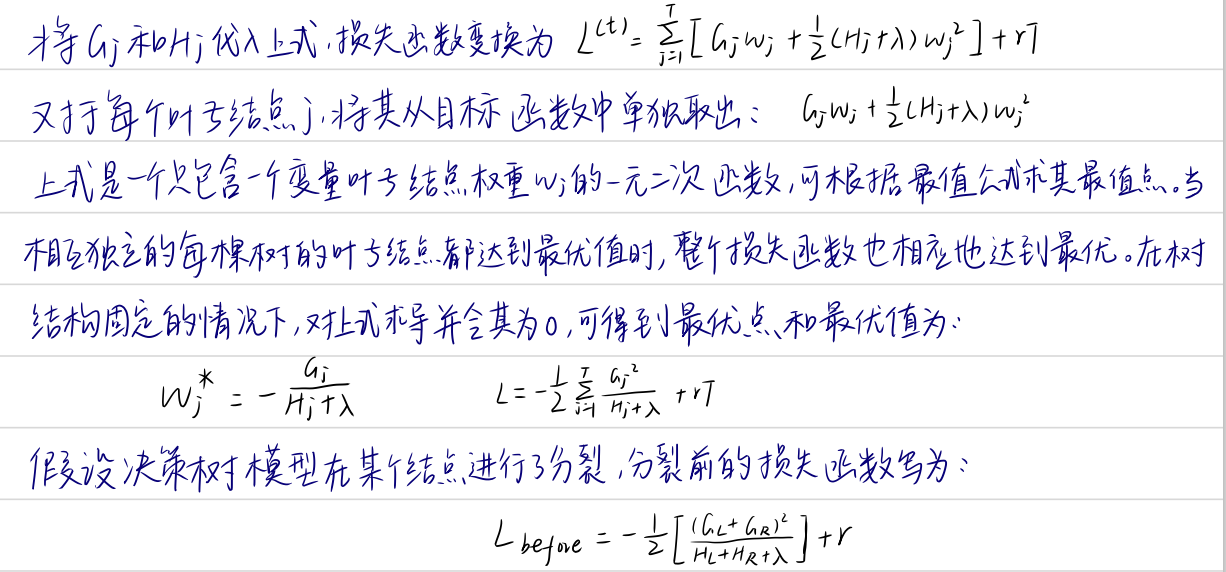
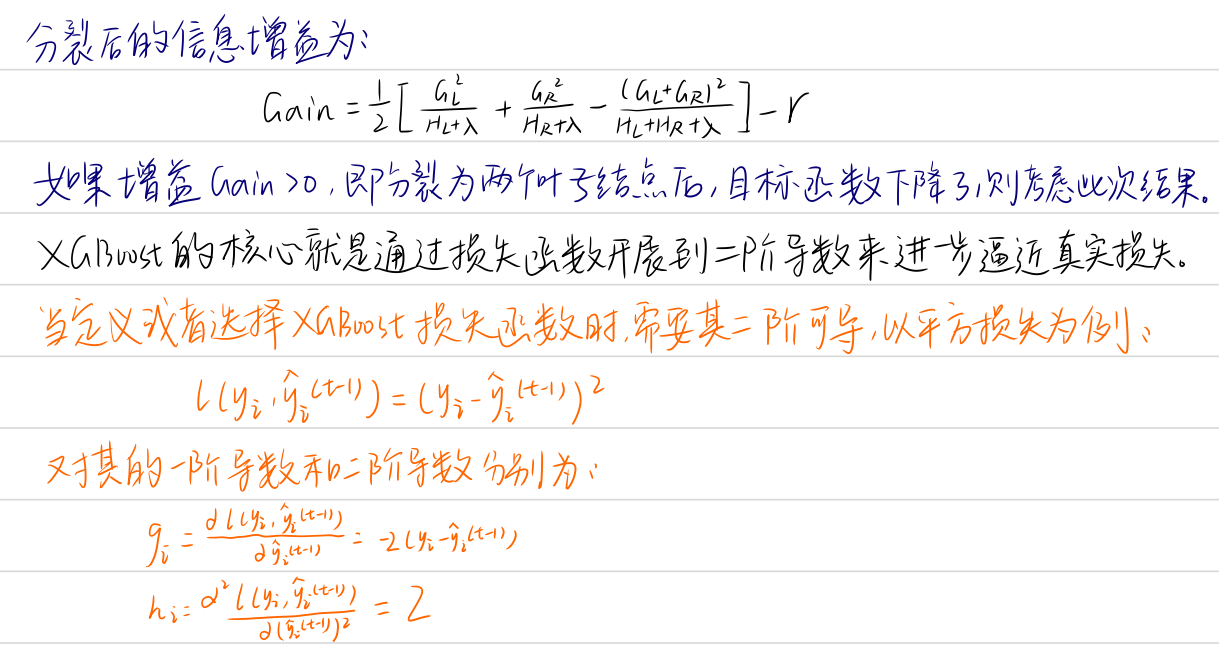
2 XGBoost算法实现
相较于GBDT,XGBoost的主要变化在于损失函数二阶导数、信息增益计算和叶子结点得分计算等方面,与上一章GBDT使用回归树不同,本章以分类树为例。
使用的决策树为CART,CART实现。
整个实现过程概括为:从损失函数出发,进行二阶泰勒展开并重新定义一棵决策树,通过对叶子结点分组得到最终的损失函数形式,最后求得最优点和最优取值,并得到叶子结点的分裂标准。
XGBoost单棵回归树类:
from cart import BinaryDecisionTree
import numpy as np
# XGBoost单棵树类
class XGBoost_Single_Tree(BinaryDecisionTree):
def node_split(self, y): # 结点分裂方法
feature = int(np.shape(y)[1]/2) # 中间特征所在列
y_true, y_pred = y[:, :feature], y[:, feature:] # 左子树为真实值,右子树为预测值
return y_true, y_pred
def gain(self, y, y_pred): # 信息增益计算方法
Gradient = np.power((y * self.loss.gradient(y, y_pred)).sum(), 2) # 梯度计算(一阶导数)
Hessian = self.loss.hess(y, y_pred).sum() # 黑塞矩阵(二阶导数)
return 0.5 * (Gradient / Hessian)
def gain_xgb(self, y, y1, y2): # 树分裂增益计算-式(12-22)
y_true, y_pred = self.node_split(y)
y1, y1_pred = self.node_split(y1)
y2, y2_pred = self.node_split(y2)
true_gain = self.gain(y1, y1_pred)
false_gain = self.gain(y2, y2_pred)
gain = self.gain(y_true, y_pred)
return true_gain + false_gain - gain
def leaf_weight(self, y): # 计算叶子结点最优权重 w*
y_true, y_pred = self.node_split(y)
gradient = np.sum(y_true * self.loss.gradient(y_true, y_pred), axis=0) # 梯度计算
hessian = np.sum(self.loss.hess(y_true, y_pred), axis=0) # 黑塞矩阵计算
leaf_weight = gradient / hessian
return leaf_weight
# 树拟合方法
def fit(self, X, y):
# 信息增益和叶子节点得分计算都用到了损失函数二阶导数信息
self.impurity_calculation = self.gain_xgb
self._leaf_value_calculation = self.leaf_weight
super(XGBoost_Single_Tree, self).fit(X, y)
XGBoost分类损失函数:
# XGBoost分类损失函数
class Sigmoid: # 定义Sigmoid类
def __call__(self, x):
return 1 / (1 + np.exp(-x))
def gradient(self, x):
return self.__call__(x) * (1 - self.__call__(x))
# 定义logit损失
class LogisticLoss:
def __init__(self):
sigmoid = Sigmoid()
self._func = sigmoid
self._grad = sigmoid.gradient
# 定义Logit损失
def loss(self, y, y_pred):
y_pred = np.clip(y_pred, 1e-15, 1, 1e-15) # 截断函数
p = self._func(y_pred)
return y * np.log(p) + (1 - y) * np.log(1 - p)
# 定义一阶梯度
def gradient(self, y, y_pred):
p = self._func(y_pred)
return -(y - p)
# 定义二阶梯度
def hess(self, y, y_pred):
p = self._func(y_pred)
return p * (1 - p)
XGBoost代码模型:
from utils import cat_label_convert
# XGBoost模型
class XGBoost:
def __init__(self, n_estimators=300, learning_rate=0.001, min_samples_split=2, min_gini_impurity=999, max_depth=2):
self.n_estimators = n_estimators # 树的棵数
self.learning_rate = learning_rate # 学习率
self.min_samples_split = min_samples_split # 结点分裂最小样本数
self.min_gini_impurity = min_gini_impurity # 结点最小基尼不纯度
self.max_depth = max_depth # 树最大深度
self.loss = LogisticLoss() # 用于分类的对数损失,回归任务定义平方损失
self.estimators = [] # 初始化分类树列表
for _ in range(n_estimators): # 遍历构造每一棵决策树
tree = XGBoost_Single_Tree(
min_samples_split=self.min_samples_split,
min_gini_impurity=self.min_gini_impurity,
max_depth = max_depth,
loss = self.loss
)
self.estimators.append(tree)
def fit(self, X, y): # XGBoost拟合方法
y = cat_label_convert(y) # one-hot
y_pred = np.zeros(np.shape(y))
for i in range(self.n_estimators): # 拟合每一棵树后将结果累加
estimator = self.estimators[i]
y_true_pred = np.concatenate((y, y_pred), axis=1)
estimator.fit(X, y_true_pred)
iter_pred = estimator.predict(X)
y_pred -= np.multiply(self.learning_rate, iter_pred)
def predict(self, X): # XGBoost预测方法
y_pred = None
for estimator in self.estimators: # 遍历预测
iter_pred = estimator.predict(X)
if y_pred is None:
y_pred = np.zeros_like(iter_pred)
y_pred -= np.multiply(self.learning_rate, iter_pred)
y_pred = np.exp(y_pred) / np.sum(np.exp(y_pred), axis=1, keepdims=True)
y_pred = np.argmax(y_pred, axis=1)
return y_pred
XGBoost代码测试:
# XGBoost测试
from sklearn.model_selection import train_test_split
from sklearn.metrics import accuracy_score
from sklearn import datasets # 导入鸢尾花数据集
data = datasets.load_iris()
X, y = data.data, data.target # 获取输入输出
X_train, X_test, y_train, y_test = train_test_split(X, y, test_size=0.2, random_state=43) # 数据集划分
clf = XGBoost() # 创建xgboost分类器
clf.fit(X_train, y_train) # 模型拟合
y_pred = clf.predict(X_test) # 模型预测
accuracy = accuracy_score(y_test, y_pred) # 准确率评估
print ("Accuracy: ", accuracy)
分类准确率:
Accuracy: 0.9333333333333333
2 XGBoost原生库示例
XGBoost的作者陈天奇也提供了XGBoost原生的工业级官方库xgboost。
首先需要指定xgboost模型训练的各种参数,包括提升树类型、任务类型、类别数量和树的最大深度等,然后将原始数据类型转换为xgboost的DMatrix数据类型,接着进行模型训练和预测,最后评估分类准确率,并绘制特征重要性图,可视化地呈现每个特征在模型中的重要性评分。
XGBoost测试:
import xgboost as xgb
from xgboost import plot_importance # 导入绘制特征重要性模块函数
from matplotlib import pyplot as plt
# 设置模型参数
params = {
'booster': 'gbtree',
'objective': 'multi:softmax',
'num_class': 3,
'gamma': 0.1,
'max_depth': 2,
'lambda': 2,
'subsample': 0.7,
'colsample_bytree': 0.7,
'min_child_weight': 3,
'eta': 0.001,
'seed': 1000,
'nthread': 4,
}
dtrain = xgb.DMatrix(X_train, y_train) # 转换为xgb数据集格式Dmatrix
num_rounds = 200 # 树的棵数
model = xgb.train(params, dtrain, num_rounds)
y_pred = model.predict(xgb.DMatrix(X_test)) # 对测试集进行验证
accuracy = accuracy_score(y_test, y_pred)
print(accuracy)
plot_importance(model)
plt.show()
输出如下:
0.9666666666666667
特征重要图可视化地呈现每个特征在模型中的重要性评分:

笔记本_Github地址